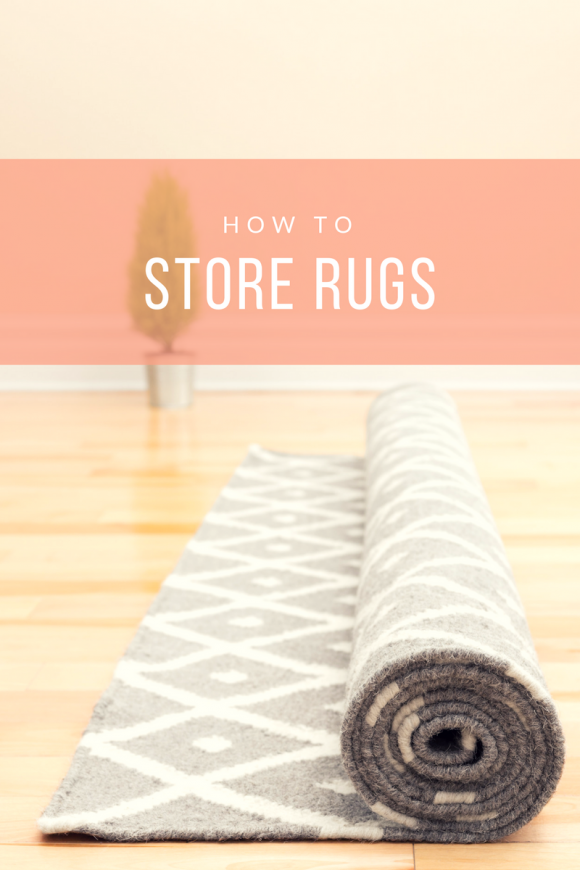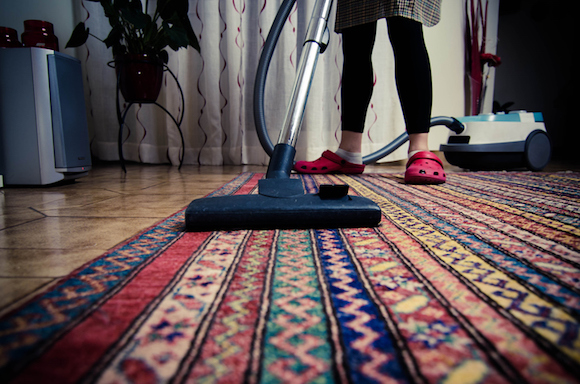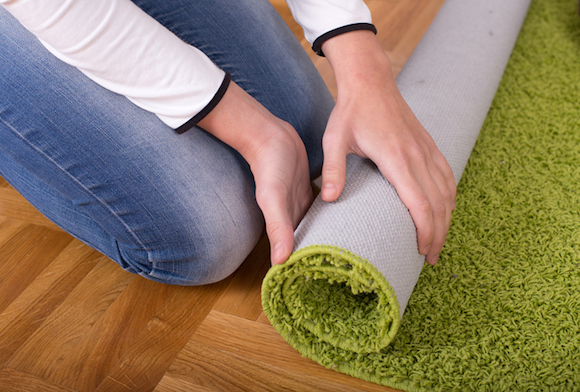If you want to hang on to a rug you’ll need later, or simply don’t have the room for a prized shag at the moment, storing it can be a solid solution.
But if you don’t store them with care, you can end up destroying your beloved collection of floor coverings.
“I have seen improperly stored textiles reduced to threads and dust in just a few months because of poor handling and storage,” said Alex Roach, a pest management consultant.
Follow these guidelines to prepare a rug and keep it in excellent condition while it’s not in use:
- Vacuum and clean the rug.
- Apply insect repellant.
- Roll up the rug, with pile on the inside.
- Wrap in a paper cover.
- Store in a dark place with low humidity.
- Check on your rug periodically to make sure there are no pests.
Continue reading for a more in-depth explanation for each of these rug storage tips.
Clean Rugs Thoroughly
“Depending on the condition, you can vacuum the piece or take it outside to beat out the dust,” advised Harriet Jones, a cleaning supervisor at Go Cleaners London. “For stubborn stains on valuable rugs, it is best to consult with professional rug cleaners.”
Professional cleaning can be costly, so you can try using a gentle detergent like Woolite to spot clean any stains. Before storing you should be sure that you have removed any pet dander, hair, dust mites so that you do not transport them to your new home. Make sure to clean both sides of the rug as well.
If the rug gets wet during the cleaning process, let it dry completely to avoid any mold or mildew problems later on. To dry your rug place it in the direct sunlight for a few hours, but no longer than that as prolonged exposure can cause colors to fade.
Protect the Rug
Moisture and bugs are two of the main risks a carpet faces during storage.
“Common rug-loving pests are silverfish, moths, and the appropriately named carpet beetle,” explained Roach.
To avoid these, apply an insect repellent made for use on rugs. Be aware that wool rugs, oriental rugs and other natural fiber rugs are particularly vulnerable to insect damage.
To protect your rug from water damage, be sure to place off the floor. You can stack some wood pallets or cinder blocks in your storage area to act as a platform for your rugs, or just place them on top of other furniture.
Rolling and Wrapping Rugs
Once it is dry, roll up the rug. Most area rugs can be rolled with the pile on the inside. If the material is fragile, however, it may be best to keep the pile outside so the foundation is not damaged. Don’t fold it, as a folded rug could easily crack or get creases in it, noted Jones.
Wrap a few strips of polyester twill tape around both ends and in the middle of the rug and tie snugly. Then wrap the rug in a paper wrapping so it can breathe and any water vapor can escape.
A couple of options to try: brown craft paper or Tyvek paper.
Keep Rugs Dark and Dry
Store rugs in a clean, dark and dry environment. Making sure that it is off the floor and doesn’t have anything else stacked on top of it.
Check that the place has no moisture or humidity in the air, and is cool and dry, suggested Matthew Iswariah of Luxzura, which offers natural rugs, throws and cushions. Choose a climate-controlled self-storage facility that will maintain the optimal temperature and humidity levels year round.
“Keep it out of reflective or direct sunlight as it can fade the color, or yellow it if you have a white sheepskin,” Iswariah said.
Another option to reduce the risk of pests is to use cold storage, noted Roach.
“Not all materials fare well in freezing temperatures, but this can be an option for some textiles,” Roach said.
Most insects will perish after just a few days when the temperature dips below 0 degrees Fahrenheit.
Check on Your Rug Regularly
If the rug is valuable, check on it once or twice a year to make sure it is still in good condition.
Watch for signs of potential damage such as live or dead insects, larval or pupal cases, frass (seed-like droppings from pests), webbing on textiles and loose fibers, advised Roach.
“Also look for changes in environmental conditions which may lead to damage, such as water leaks or mold.”
You might also apply another coat of insect repellent to keep bugs away, especially when storing wool rugs.
If you do note some pest infestation on the material, you can try freezing it, explained Roach. Seal the rug in a bag, such as a garbage bag, and place it in a freezer for three or more days. Then let the rug thaw completely before opening the bag.
When you’re ready to bring the rug back home, disinfect it first, suggested Jones. If you have a steam cleaner, you may be able to do this yourself. If not, call a professional carpet technician.
Finally vacuum the piece before setting it up in its new home to remove any lingering dust or odors.





